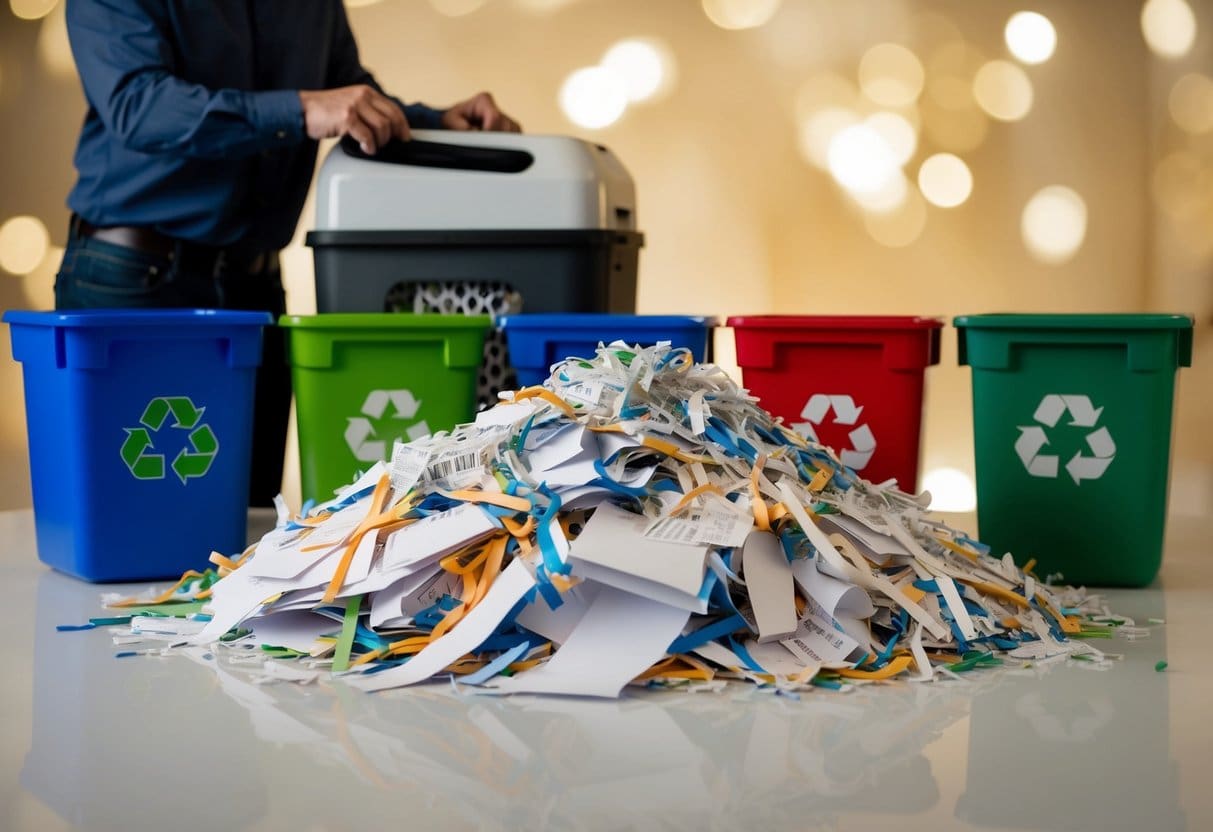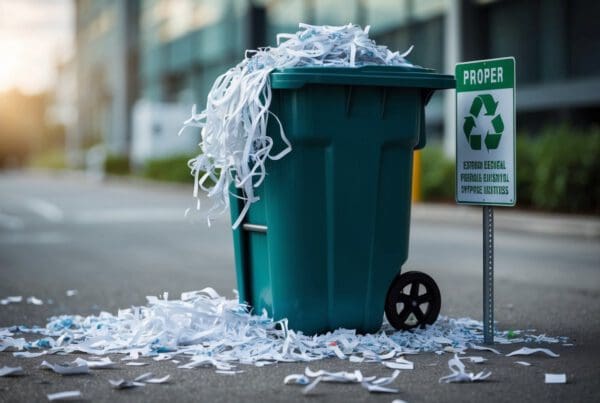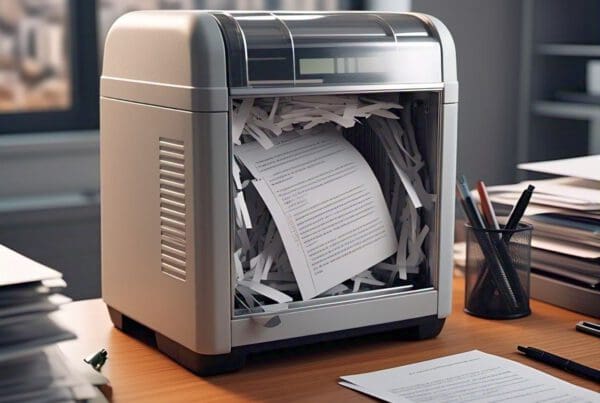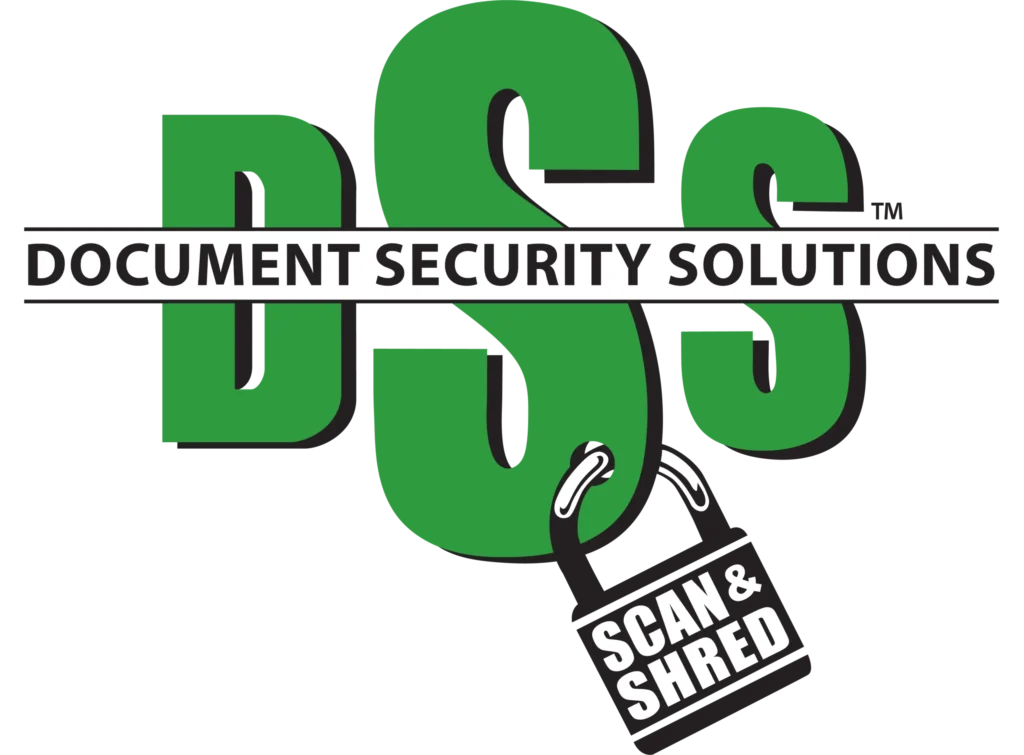Shredded Paper Recycling

Recycling shredded paper can be tricky due to its short fibers and potential contamination. In this section, we explore the types of shredded paper that can be recycled and why proper document destruction is key.
Types of Shredded Paper and Recyclability
Shredded paper comes in various types, each affecting its recyclability. Cross-cut and strip-cut are the most common. Cross-cut is harder to recycle because its fibers are much shorter. Strip-cut is relatively easier, but recycling centers may have different policies.
Recycling shredded paper efficiently requires it to be clean and free from non-paper materials like plastic or metal bits. Some centers accept shredded paper if it’s bagged separately in a paper bag. It’s important to check local recycling guidelines to ensure the shredded paper is processed correctly.
The Importance of Proper Document Destruction
Proper document destruction is vital for keeping sensitive information secure. When we handle documents containing personal or confidential data, shredding them helps protect against identity theft and unauthorized access. This is especially significant for businesses that deal with customer information.
Sensitive documents should be shredded in a way that they cannot be reconstructed. We need to consider using cross-cut shredders for more security. Disposing of shredded paper through secure recycling channels ensures that our data remains protected while contributing to environmental sustainability.
Preparing Shredded Paper for Recycling
To recycle shredded paper effectively, we need to focus on keeping the paper clean and ensuring it meets the requirements set by local recycling facilities. This involves careful sorting and staying informed about local guidelines.
Sorting and Contamination Avoidance
Keeping shredded paper free from contaminants is crucial. We must always separate paper from other materials like plastic or metal. Stickers, paperclips, and staples should be removed as they can cause issues.
Sometimes even small amounts of food or grease can ruin an entire batch. It’s best to store shredded paper in a clean, dry spot. We should also consider using paper bags for collection since plastic bags can sometimes complicate the recycling process.
Adhering to Local Recycling Guidelines
Local recycling guidelines often vary. It’s vital that we check with our local recycling facilities before sending off shredded paper. Many places require shredded paper to be in clear plastic bags or paper bags tied at the top to avoid spills.
Some facilities might have specific days for collecting shredded paper or offer drop-off locations. Being informed helps us ensure that our efforts support the recycling process efficiently. Certain types of shredded paper might even be excluded, such as glossy or brightly colored paper.
By following these steps, we ensure that our shredded paper gets recycled properly and contributes to a cleaner environment. Familiarizing ourselves with the specific rules in our area makes the process smoother and more effective.
Alternatives to Recycling Shredded Paper

There are effective ways to repurpose shredded paper beyond just recycling it. We can compost it to enrich our gardens or use it creatively for various purposes.
Composting with Shredded Paper
Composting is an excellent way to use shredded paper. It adds carbon, which balances the nitrogen-rich materials like food scraps. By mixing shredded paper with damp compost ingredients, we create a healthy environment for worms and microbes. These help break down the pile efficiently.
We should avoid glossy or heavily printed paper as they might contain toxins. Including shredded paper in our compost helps control moisture levels. It also prevents matting, allowing air to circulate better. This boosts the breakdown process and reduces odor. By composting, we reduce landfill waste while enriching our garden soil.
Creative Reuses for Shredded Paper
Shredded paper is useful in many creative ways. It works well as packing material for fragile items. Its soft texture cushions items, preventing damage during shipping. As pet bedding, it’s suitable for small animals like hamsters or guinea pigs. Shredded paper is absorbent and provides a cozy environment for them.
We can also use it to make DIY firestarters. By packing it into paper towel tubes with some wax, they are easy to light and perfect for campfires. Our aim is to find new ways to reuse shredded paper. This not only helps the environment but also serves practical purposes in our daily lives.
Navigating Recycling Programs and Facilities
Recycling shredded paper can be challenging, but there are a few programs and facilities that can help. We can look into curbside recycling and locate specialized centers for effective ways to recycle shredded paper.
Curbside Recycling Programs for Paper
Curbside recycling programs often accept paper, but shredded paper may require special handling. It’s important for us to check with our local waste management company to confirm what their specific guidelines are.
Some programs require shredded paper to be in clear plastic bags. This prevents it from getting mixed with larger recyclables, which can cause processing issues at recycling facilities. Other areas might decline shredded paper altogether due to its fine particles complicating the sorting.
In some places, we might find that community shredding events offer a solution. These events often ensure that shredded paper gets processed efficiently. We might need to follow certain preparation steps, like removing staples and other non-paper materials, to ensure the paper is easy to recycle.
Locating Specialized Shredded Paper Recycling Centers
If curbside programs don’t accept shredded paper, specialized recycling centers are a viable option. We can start by searching online for local recycling centers that list paper shredding services. Some facilities are equipped to handle fine, shredded paper materials better.
Local government websites can be helpful resources for finding these centers and learning their guidelines. They might provide lists of facilities approved for the recycling of shredded paper. Travel might be required, so considering the distance is essential for us.
Additionally, some eco-friendly businesses might have partnerships with recycling centers. They can offer drop-off locations within our community for these materials. By staying informed and exploring our community’s resources, we can find the best way to recycle our shredded paper responsibly.
Shredded Paper Disposal Best Practices
When it comes to disposing of shredded paper, considering both the environment and privacy is crucial. We must balance recycling efforts while ensuring sensitive information remains protected.
Environmental Considerations in Paper Disposal
Shredded paper can be a little tricky in terms of recycling. Because the fibers are shortened, not every recycling center accepts it. Check local recycling guidelines to confirm if they handle shredded paper.
We can use shredded paper for composting. It’s a great addition to the compost bin, enriching soil and minimizing waste. Alternatively, it can be used as a firestarter in fireplaces. Both methods are eco-friendly options that benefit us by reducing waste and enhancing sustainability.
Safe Disposal of Shredded Paper with Sensitive Information
Handling shredded paper that contains sensitive information requires extra care. Before disposal, ensure the use of a reliable paper shredder. It’s important that the shred size is small enough to prevent data reconstruction.
Once shredded, separate this paper from regular disposables. It may be best to bag it securely to prevent scattering during further handling. Participating in community shredding events offers an excellent option for safe disposal. Through these events, organizations often ensure secure shredding and disposal. This approach balances data security with environmental responsibility.





